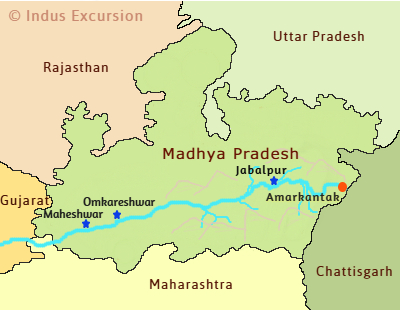
Narmada river is mostly referred as the oldest river of India and most sacred river of Madhya Pradesh and Gujarat states. This is the foremost important introduction for this river. It is much older than popular river Ganges. Here in India, it was referred by many names like Narbada by local people. During British India period, they spelt it as Nerbudda river. As its origin is from Maikal range thus also called Mekalsuta. At the time of worship and religious ceremonies, it is also referred with name of Rewa. It has its origin from Amarkantak plateau of Madhya Pradesh state in Central India. It flows towards west direction. Its one way length is approx. 1312 km and ultimately falls into Arabian sea, close to Bharuch, Gujarat. It is considered as 5th longest river of India
It is believed that Narmada river originated after the dispersion of Gondwana land and different continents came into existence. Due to ancient river, Narmada river valley is considered as fossil rich and thus majority of fossils were discovered in and around this river flow route. It originates from Amarkantak plateau, from dense forests and this origin point referred as Narmada udgam. It mainly flows through rifts and valleys with rocky boundaries. During its journey, it passes through many cities and tourist spots like Jabalpur, Hoshangabad, Omkareshwar, Maheshwar, Bharuch etc.
History of Narmada river is not acurately defined but due to discovery of fossil remains in this river valley, one thing is sure that it is the oldest river of India. It emerged after Gondwana land dispersion took place and new continents were formed. Till that time, Himalayan range was not formed thus Narmada river is much older than Himalayas. When Himalayan range was not present then it means, river Ganges was also not present which proves the fact that Narmada river is much older than Ganges thus in Hindu mythology, it is popularly said that holy river Ganges takes a holy dip in Narmada river, to purify itself. As per Hindu mytholody, it is believed that Narmada river born from lord Shiva's sweat. In reality, origin of Narmada river is at Amarkantak plateau and flows in western direction. Narmada river valley is believed to be home of ancient human civilization which is supported by the founding of paleolithic stone tools and dinosaur fossils. Major fossil parks are close to the route of this river. In past this river was also used as a political boundary of kingdoms like it separates Mughal empire from Deccan sultanates.
Narmada river is counted among most sacred rivers of India. As per its role and local deities, river got many names. Some of the popular alternate names of Narmada river are as follows:
| Narmada River Names | Explanation | ||
| Rewa | It is the most ancient name, referred in many Hindu epic books which simply means one that leaps. River passes through many rocky terrains, forming small falls, cascading flow thus referred by this name. | ||
| Purvaganga | It means Ganges of East. Those who are not able to visit Ganges, they visit Narmada river for sacred reasons thus given the name as "Ganges of West". | ||
| Shankari | In Hindu mythology, it is believed that Narmada river is originated from Lord Shiva, through precipitation during meditation practice, thus called daughter of Shiva. | ||
| Mahatirthsa | Simply means highty sacred river for pilgrimage purpose. | ||
| Samodbhava | It means born of the moon. | ||
| Narmadi | Refers toe the feminine nature of Narmada river. As Hindu people worships nature thus treat them as god or godess. This indicates that Narmada river is in godess category. | ||
| Jitashila | It means victorious river, which crosses all the obstacles, coming on its pathway. | ||
| Revati | Poetic variant derived from alternate name of river Rewa. | ||
| Girinarma | It means the one flowing from the mountains | ||
| Vipapa | It means sinless or purifier. In Hindus, it is believe that just by watching Narmada river, she will purify your soul, destroy all your sins. | ||
Many times, after visiting Amarkantak's Narmada udgam point (river origin), tourists raise question that at starting point, river have very limited amount of water but when we see the same river at Mandla town or at Jabalpur or in Maheshwar, water quantity seems enormous. From where this additional water comes. So we humbly answer them that this additional amount of water is coming from its contributary rivers. Here we will find that water is coming from both the sides of river. Large number of small and large rivers are present on both the sides which completes their journey by meeting river Narmada. For example Kanha tiger reserve have two main river valleys like Halon river and Banjar river and both of them meets Narmada river. Similarly Gaur river in Jabalpur, Sonbhadra + Denwa + Tawa rivers of Satpura tiger reserve are contributing whole water to Narmada river. These are only few examples. It shows that during its journey, river get consistent supply of water from various sources which maintains its level and makes it evergreen.